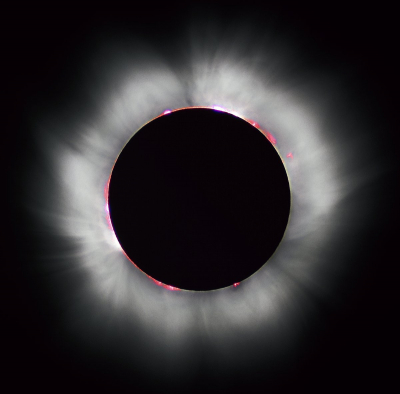A total solar eclipse took place on 1314 November 2012 (UTC). Because it crossed the International Date Line it began in local time on November 14 west of the date line over northern Australia, and ended in local time on November 13 east of the date line near the west coast of South America. Its greatest magnitude was 1.0500, occurring only 12 hours before perigee (Perigee on 2012 Nov 14 at 10:11:48 UTC), with greatest eclipse totality lasting just over four minutes. A solar eclipse occurs when the Moon passes between Earth and the Sun, thereby totally or partly obscuring the image of the Sun for a viewer on Earth. A total solar eclipse occurs when the Moon's apparent diameter is larger than the Sun's, blocking all direct sunlight, turning day into darkness. Totality occurs in a narrow path across Earth's surface, with the partial solar eclipse visible over a surrounding region thousands of kilometres wide.
It was the 45th eclipse of the 133rd Saros cycle, which began with a partial eclipse on July 13, 1219 and will conclude with a partial eclipse on September 5, 2499.
A solar eclipse occurs when a portion of the Earth is engulfed in a shadow cast by the Moon which fully or partially blocks sunlight. This occurs when the Sun, Moon and Earth are aligned. Such alignment coincides with a new moon (syzygy) indicating the Moon is closest to the ecliptic plane. In a total eclipse, the disk of the Sun is fully obscured by the Moon. In partial and annular eclipses, only part of the Sun is obscured.
If the Moon were in a perfectly circular orbit, a little closer to the Earth, and in the same orbital plane, there would be total solar eclipses every new moon. However, since the Moon's orbit is tilted at more than 5 degrees to the Earth's orbit around the Sun, its shadow usually misses Earth. A solar eclipse can occur only when the Moon is close enough to the ecliptic plane during a new moon. Special conditions must occur for the two events to coincide because the Moon's orbit crosses the ecliptic at its orbital nodes twice every draconic month (27.212220 days) while a new moon occurs one every synodic month (29.53059 days). Solar (and lunar) eclipses therefore happen only during eclipse seasons resulting in at least two, and up to five, solar eclipses each year; no more than two of which can be total eclipses.Total eclipses are rare because the timing of the new moon within the eclipse season needs to be more exact for an alignment between the observer (on Earth) and the centers of the Sun and Moon. In addition, the elliptical orbit of the Moon often takes it far enough away from Earth that its apparent size is not large enough to block the Sun entirely. Total solar eclipses are rare at any particular location because totality exists only along a narrow path on the Earth's surface traced by the Moon's full shadow or umbra.
An eclipse is a natural phenomenon. However, in some ancient and modern cultures, solar eclipses were attributed to supernatural causes or regarded as bad omens. A total solar eclipse can be frightening to people who are unaware of its astronomical explanation, as the Sun seems to disappear during the day and the sky darkens in a matter of minutes.
Since looking directly at the Sun can lead to permanent eye damage or blindness, special eye protection or indirect viewing techniques are used when viewing a solar eclipse. It is safe to view only the total phase of a total solar eclipse with the unaided eye and without protection. This practice must be undertaken carefully, though the extreme fading of the solar brightness by a factor of over 100 times in the last minute before totality makes it obvious when totality has begun and it is for that extreme variation and the view of the solar corona that leads people to travel to the zone of totality (the partial phases span over two hours while the total phase can last only a maximum of 7.5 minutes for any one location and is usually less). People referred to as eclipse chasers or umbraphiles will travel even to remote locations to observe or witness predicted central solar eclipses.

2012Nov, 13
A total solar eclipse occurred in parts of Australia and the South Pacific
Choose Another Date
Events on 2012
- 13Jan
Costa Concordia disaster
The passenger cruise ship Costa Concordia sinks off the coast of Italy due to the captain's negligence and irresponsibility. There are 32 confirmed deaths. - 2Jun
2011 Egyptian revolution
Former Egyptian President Hosni Mubarak is sentenced to life imprisonment for his role in the killing of demonstrators during the 2011 Egyptian revolution. - 19Jun
Julian Assange
WikiLeaks founder Julian Assange requested asylum in London's Ecuadorian Embassy for fear of extradition to the US after publication of previously classified documents including footage of civilian killings by the US army. - 11Sep
2012 Benghazi attack
The U.S. embassy in Benghazi, Libya is attacked, resulting in four deaths. - 23Oct
Digital switchover
After 38 years, the world's first teletext service (BBC's Ceefax) ceases broadcast due to Northern Ireland completing the digital switchover.

 English
English  español
español  français
français  português
português  русский
русский  العربية
العربية  简体中文
简体中文 